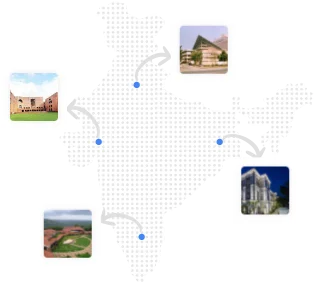Philippines
An archipelagic nation in Southeast Asia, the Philippines is officially known as the Republic of the Philippines. It is in the western Pacific Ocean and is made up of approximately 7,641 islands. From north to south, it is divided into three main geographical regions: Luzon, Visayas, and Mindanao. The Celebes Sea lies to the southwest, the Philippine Sea to the west, and the South China Sea to the east. Taiwan to its north, Japan to its northeast, Palau to its east and southeast, Indonesia to its south, Malaysia to its southwest, Vietnam to its west, and China to its northwest are its maritime neighbors. The Philippines has a land area of 120,000 square miles and a population of approximately 109 million as of 2021, making it the thirteenth most populous country in the world. The islands of the Philippines are home to a wide range of ethnic and cultural groups. The nation's capital is Manila, while Quezon City is the largest city; Both are in Metro Manila's urban core.
After the Negritos, who were some of the first people to live in the archipelago, came successive waves of Austronesian people. Island kingdoms known as Kedatuan, Rajahnates, and Sultanates were established following the adoption of animism, Hinduism, and Islam. The beginning of Spanish colonization was marked by the arrival of Ferdinand Magellan, a Portuguese explorer leading a fleet for Spain. In 1543, Spanish adventurer Ruy Lopez de Villalobos named the archipelago Las Islas Filipinas to pay tribute to Philip II of Spain. Spanish settlement through Mexico, starting in 1565, prompted the Philippines becoming administered by the Spanish Realm for over 300 years. During this time, Manila became the western hub of trans-Pacific trade and Catholicism took over as the dominant religion. The Philippine Revolution began in 1896 and became intertwined with the Spanish–American War in 1898. The territory was given to the US by Spain, and Filipino revolutionaries established the First Philippine Republic. The following Philippine–American War came to an end with the United States taking control of the land, which they did until the Japanese invaded the islands during World War II. In 1946, the Philippines gained independence following liberation. From that point forward, the unitary sovereign state has frequently had a wild involvement in vote based system, which incorporated the defeat of a decades-in length tyranny by a peaceful upset.
The Philippines' economy is moving away from agriculture and toward services and manufacturing, making it both an emerging market and a newly industrialized nation. It was a founding member of ASEAN, the Asia-Pacific Economic Cooperation forum, the East Asia Summit, the World Trade Organization, and the United Nations. The Philippines' position as an island nation in the Pacific Ring of Fire close to the equator makes it vulnerable to typhoons and earthquakes. The nation has various regular assets and is home to a universally huge degree of biodiversity.
Why to study in Philippines
- Living and studying in the Philippines is very affordable You won't have to break the bank to study there. When compared to popular study destinations like the United States or the United Kingdom, the nation has very low tuition costs. Because the cost of living is also reasonable, you can put more money into traveling to the islands and exploring them.
- When studying abroad, it can quickly become a problem to not speak the local language, especially if English is not widely spoken. In the Philippines, you won't have this problem, which is a good thing. In all educational establishments, from kindergartens to universities, the archipelagic nation uses English as the standard language of instruction.
Along with Filipino, English is the language of the country. This means that on a night out, you can easily talk to the locals, get directions, or order anything you want. - Students can take a much-needed break after classes in the Philippines, a tropical paradise with over 7,000 islands, pristine beaches, and vibrant coral reefs. You won't have to worry at all because of the tropical climate and sunny weather. Explore other national treasures like stunning waterfalls, mountains, and rainforests if you don't like the beach.
- The education system that is based in the United States is another aspect that deserves to be mentioned. That is correct. The college system in the Philippines is comparable to that in the United States, with the same benefits and solid structure but without student debt and high tuition costs.
Top Universities of Philippines
1. Ateneo de Manila University
The Society of Jesus founded and runs the private research, basic, and higher education institution known as the Ateneo de Manila University (AdMU), which is also known as the Ateneo de Manila, the Ateneo, or AdMU.
2. University of Santo Tomas
The University of Santo Tomas (otherwise called UST and formally as the Ecclesiastical and Imperial University of Santo Tomas, Manila) is a private, Catholic exploration college in Manila, Philippines. It is one of the largest Catholic universities in the world in terms of the number of students enrolled on a single campus and was established on April 28, 1611, by the Spanish friar Miguel de Benavides, who was the third Archbishop of Manila. It has the oldest university charter in the Philippines and in Asia. It is the fundamental grounds of the University of Santo Tomas Framework that is controlled by the Request for Ministers.
3. University of the Philippines Diliman
A public, coeducational, research basic and higher education institution in Diliman, Quezon City, Philippines, the University of the Philippines Diliman is also known as UPD, UP Diliman, or simply UP.
4. Mapua University
Mapua University, more commonly referred to as MU or simply Mapua, is a private, non-sectarian university in Metro Manila, Philippines. The college was established in 1925 by the main enlisted Filipino planner, Tomas Mapua, an alum of Cornell College in New York.
5. University of the Philippines Manila
Ermita, Manila, Philippines is home to the state-funded medical and research institution known as the University of the Philippines Manila. It is well-known for being the nation's center of excellence in the health sciences, including education, training, and research for health professionals.
Places to Visit while Travelling Philippines
1. San Agustin Church
One of the Philippines' oldest churches, San Agustin Church was built in 1586. The San Agustin Church, which UNESCO has designated a World Heritage Site, is regarded as one of the Philippines' most significant tourist attractions. This church has undergone a number of renovations, the most recent of which occurred in 2013, and it has a stunning architectural design that is reminiscent of the Baroque style.
2. National Museum of the Philippines
If you want to learn more about the culture, history, and traditions of the Philippines, the National Museum of the Philippines is one of the best places to visit in the country. The museum has four main sections, each with its own unique collection of interesting artifacts. Collections of natural history, archaeology, art, zoology, anthropology, and biology can be seen here.
3. Chocolate Hills
The Chocolate Hills, which are situated in the Carmen region of Bohol Island and are well-known for their scenic features, are regarded as one of the most picturesque destinations in the Philippines. The Chocolate Hills, spread out over about 50 square kilometers, are a great place to get a great view of the majestic hills in the shape of cones.
4. Banaue Rice Terraces
In the past, the famed Banaue Rice Terraces were nothing more than winding fields that embraced a mountainside. Young farmers are currently revitalizing these plantations, despite the fact that the locals had completely abandoned this location.
5. Siargao
One of the most well-known surfing destinations in the Philippines is Siargao. Despite its small size—it looks like a teardrop—the island is a popular destination. White-sanded beaches line the entire island, and the water is a beautiful shade of turquoise. There are also lagoons and waterfalls inside the park, both of which are popular spots for unwinding and recharging.


